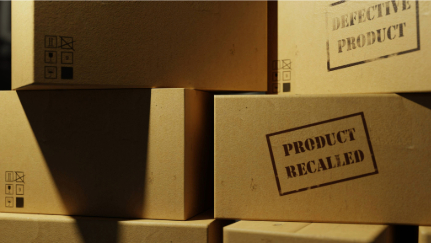
If it seems like every week there is another recall in the news, it’s not your imagination. According to Sedgwick's 2025 U.S. State of the Nation Recall Index report , in 2024 there were 3,232 recalls across five major industries.
This includes a number of high-profile food recalls that made headlines for weeks for onions, dairy products and a top deli-meat brand.
“Class I recalls are the most severe category,” explains Marcy Pelecky, vice president of Casualty Programs at Nationwide E&S/Specialty. “This is a recall that occurs due to the reasonable probability that using or being exposed to a product will cause serious adverse health consequences or death.”
How food contamination happens
The modern food chain is complex, which means there are many opportunities along the way where things can go wrong. Contamination can happen at any point during food production, including where animals are raised and fruits and vegetables are grown.
“It typically starts with the facility itself,” says Pelecky. “Do they have a culture of safety? Are they following all the appropriate processing procedures? Is the available workforce sufficient?”
If it’s not properly and constantly sanitized, processing equipment can be a culprit, too. Some food travels a long distance from where it is grown and processed to where it is sold, and improper handling and storage can cause food to become contaminated.
“A lot of different problems can happen, which is why it is so important for businesses to have a traceability system so they can go back and figure out where along the chain that product potentially became contaminated,” Pelecky adds.
The impact of food recalls
Just one product recall can have a lasting impact on a company if they’re not prepared. According to a joint study by the Food Marketing Institute, the Grocery Manufacturers Association, GS1 US and Deloitte , the average cost of a food recall is $10 million.
“If a company doesn’t have the proper insurance coverage, a single recall could potentially put them out of business,” notes Pelecky.
Beyond financial losses, recalls can have staying power in the minds of consumers who may not want to purchase a branded product again for months or years to come, depending on the severity of the contamination, how widespread it was and how much media coverage it received.
“Recalls can most definitely damage a company’s reputation over the long-term,” she says.
Most importantly, there is a human cost if people were sickened by the contaminated product.
Mitigating risk with the right protection
Getting the right insurance coverage is critical for businesses whose products are at risk for recall. Pelecky explains that it’s critical to have two kinds of insurance for complete protection: general liability and product recall insurance.
“If you put out a product and people get sick, general liability provides coverage for the harm done to the people,” she says. “On the other hand, recall insurance helps cover the manufacturer’s financial loss due to the costs of recalling the product.”
The two types of insurance work together to provide broader protection from the different kinds of exposure related to product recall. Because of this, it’s important to ensure the language on both policies is precise and that gaps are minimal or are eliminated.
“Every insured has unique needs depending on the size of their business, what kind of products they manufacture or sell, and other factors,” says Pelecky.
She advises businesses to work with experienced brokers who specialize in product recall and understand the specific coverages and limits they require.
“At Nationwide, we’re able to customize policies to provide companies with the personalized protection they need,” she says.
Leaning into expert advice
Recall experts can also help businesses reduce their risk and increase their resilience before a problem occurs.
“At Nationwide, we partner with Axon Crisis Management,” explains Pelecky. “They are true experts in the product recall and foodborne illness arena.”
Working with professionals like those at Axon Crisis Management can help businesses create pre-incident plans, including mock recall exercises, so they are prepared if and when a real recall occurs.
“Product recalls are frequent across the manufacturing world but are rare and very different when it comes down to each individual company,” says Alex Pittignano, senior vice president and partner at Axon Crisis Management. “When a recall situation occurs, the first 48 hours will be critical to reduce the financial impact both short and long term. As with many things in life, practice makes permanent, and product recall preparation is no exception.”
Axon Crisis Management can also help organize an assessment of the safety culture at the organization so it can identify opportunities to ingrain safe practices in its operations and chain of command.
“Ultimately, we want to make sure there is a plan in place before a recall happens,” says Pelecky. “Of course, as the saying goes, the best loss is the loss that never happens.”
Prioritizing protection
When companies invest in reducing their exposure and putting the right protection in place, they are increasing their chances of weathering the effects of a recall should one occur.
“Some companies see product recall as a luxury coverage because they never think it will happen to them,” notes Pelecky. “However, there are a lot of first-time buyers out there that are recognizing the need to have this appropriate protection and insurance.”
Learn more about Axon Crisis Management’s food safety solutions.